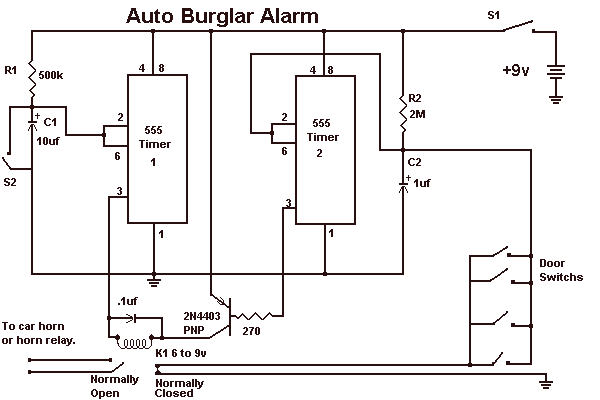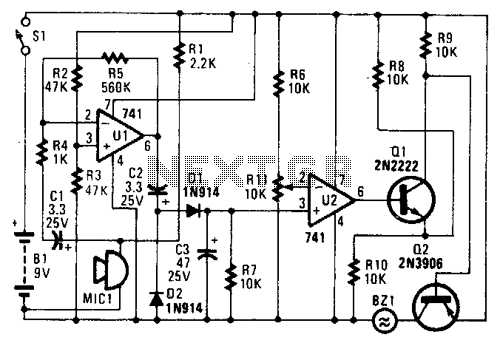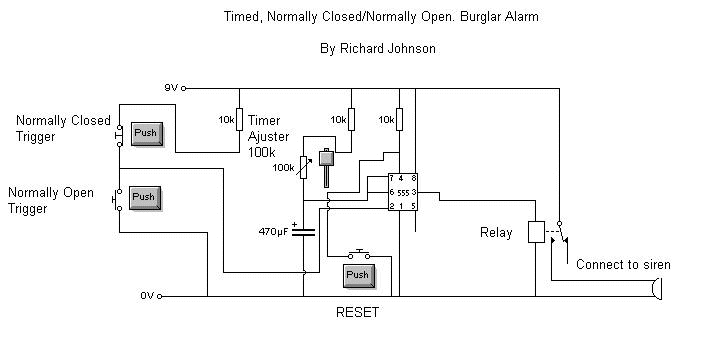
Burglar Alarm with 555

This alarm circuit is based on two 555 timers. The alarm will sound your car horn if anyone opens the car door while the circuit is armed. The timers will allow you to leave the car without sounding the horn. To turn the circuit on S1 must be closed. To set the alarm, open S2 (it is normally closed) this will give you about 5 seconds to get out and close the door. The exit delay time is set by R1 and C1. If anyone opens the doors for more than two seconds the horn will sound until power is removed from the circuit. The 2 second time is set by R2 and C2. If you open the door, you must deactivate the alarm by closing S2. This very basic circuit could be used for a home also.
The alarm circuit utilizes two 555 timer integrated circuits (ICs) configured in monostable and astable modes to achieve its functionality. The first 555 timer is set up in monostable mode to create a delay when the alarm is armed. When the switch S1 is closed, the circuit becomes active. The timer is initiated by opening the normally closed switch S2, which allows the user approximately five seconds to exit the vehicle and close the door. The timing of this delay is determined by the resistor R1 and capacitor C1, which can be selected to provide the desired exit delay.
The second 555 timer is configured to monitor the status of the car door. If the door is opened while the circuit is armed, the timer starts counting. The time delay before the alarm triggers is set to two seconds, which is adjustable through the resistor R2 and capacitor C2. If the door remains open for longer than this duration, the circuit activates the car horn, creating an audible alert. The output of the second timer is connected to a relay or transistor that controls the power to the car horn, ensuring that the alarm is loud enough to be heard.
To deactivate the alarm, the user must close switch S2, which resets the first 555 timer and stops the horn from sounding. This circuit design is not only applicable to automotive security but can also be adapted for home security applications, providing a simple and effective solution for protecting personal property. Proper selection of components and careful layout of the circuit board will ensure reliability and performance in various environments.This alarm circuit is based on two 555 timers. The alarm will sound your car horn if anyone opens the car door while the circuit is armed. The timers will allow you to leave the car without sounding the horn. To turn the circuit on S1 must be closed. To set the alarm, open S2 ( it is normally closed ) this will give you about 5 seconds to get out and close the door. The exit delay time is set by R1 and C1. If anyone opens the doors for more then two seconds the horn will sound until power is removed from the circuit.
The 2 second time is set by R2 and C2. If you open the door, you must deactivate the alarm by closing S2. This very basic circuit could be used for a home also. 🔗 External reference
The alarm circuit utilizes two 555 timer integrated circuits (ICs) configured in monostable and astable modes to achieve its functionality. The first 555 timer is set up in monostable mode to create a delay when the alarm is armed. When the switch S1 is closed, the circuit becomes active. The timer is initiated by opening the normally closed switch S2, which allows the user approximately five seconds to exit the vehicle and close the door. The timing of this delay is determined by the resistor R1 and capacitor C1, which can be selected to provide the desired exit delay.
The second 555 timer is configured to monitor the status of the car door. If the door is opened while the circuit is armed, the timer starts counting. The time delay before the alarm triggers is set to two seconds, which is adjustable through the resistor R2 and capacitor C2. If the door remains open for longer than this duration, the circuit activates the car horn, creating an audible alert. The output of the second timer is connected to a relay or transistor that controls the power to the car horn, ensuring that the alarm is loud enough to be heard.
To deactivate the alarm, the user must close switch S2, which resets the first 555 timer and stops the horn from sounding. This circuit design is not only applicable to automotive security but can also be adapted for home security applications, providing a simple and effective solution for protecting personal property. Proper selection of components and careful layout of the circuit board will ensure reliability and performance in various environments.This alarm circuit is based on two 555 timers. The alarm will sound your car horn if anyone opens the car door while the circuit is armed. The timers will allow you to leave the car without sounding the horn. To turn the circuit on S1 must be closed. To set the alarm, open S2 ( it is normally closed ) this will give you about 5 seconds to get out and close the door. The exit delay time is set by R1 and C1. If anyone opens the doors for more then two seconds the horn will sound until power is removed from the circuit.
The 2 second time is set by R2 and C2. If you open the door, you must deactivate the alarm by closing S2. This very basic circuit could be used for a home also. 🔗 External reference





